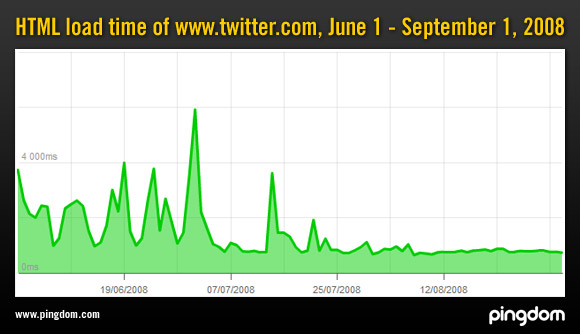Right around this time of year, you’re going to start seeing Predictions for 2009. Let me post mine: 2009 is the year you as the CEO of your microISV, startup or ISV get on Twitter.
For those of you who’ve managed to avoid Twitter, or dismissed it as some pointless flakey time waster, here’s a few current facts you should consider:
- Twitter usage is skyrocketing. In October alone, Twitter experienced a 25% climb in traffic, according to comScore, bringing the number of active Twitterers in the U.S. alone to 1.45; worldwide in September it was 5.6 million.
- Twitter has just about retired the “fail whale”. While in the first quarter of 2008 Twitter had more than a few crashes, those issues have been resolved, as this chart from the Royal Pingdom Blog shows:
- Companies – both micro and not – are being wildly successful using Twitter as a way of providing online customer service (read marketing). More about two examples of that next.
What’s going on here?
So how is it that a funky way to post 140 characters at a time has grown 16-fold in one year? It’s called the Cluetrain Manifesto. Way back in 1999, four really smart people decided it was time to nail what the new digital reality meant for marketing and advertising to Mainstream Advertising’s front door. Their 95 theses spell out why mainstream media right to interrupt every other human activity was eroding under Internet pressure.
Here’s the gist (do yourself a favor and read the full Manifesto): Markets are conversations. It doesn’t matter where that conversation happens, be it between bloggers, in social networks or on services like Twitter; the conversation is the market and companies better get a clue fast.
The first six theses break this down further:
- Markets are conversations.
- Markets consist of human beings, not demographic sectors.
- Conversations among human beings sound human. They are conducted in a human voice.
- Whether delivering information, opinions, perspectives, dissenting arguments or humorous asides, the human voice is typically open, natural, uncontrived.
- People recognize each other as such from the sound of this voice.
- The Internet is enabling conversations among human beings that were simply not possible in the era of mass media.
Sounds like a working definition of Twitter to me.
Show me the Money
Let me walk you through two examples of how savvy online entrprenures are making use of Twitter. Let’s start with Peldi Guilizzoni, the founder of Balsamiq Studios and creator of Balsamiq Mockups, a great Adobe AIR app that I and other startups have learned to love for mocking up screens. In a nutshell, Peldi has running as a background task in his workday a constantly updating RSS feed from search.twitter.com of keywords that relate to his product.
“When someone tweets something relevant, and I feel that my tool might help them, I tweet back with a link”, Peldi said in this post. “I have had an incredible success rate with this direct way to advertise my Mockups tool.”
Now Peldi has refined this technique further – and you would be well advised to read the rest of his post or listen to my interview with him before proceeding.
But here’s the killer point: In less than five months, Basalmiq has taken in it’s first $100,000 of revenue, Peldi has quit his day job and Peldi has garnered some really great press, including being interviewed on the highly IT popular net@night podcast.
Now granted, given the way Conversation works on the web, microISVs and startups have a built-in advantage: we can’t help but be real human beings and not anonymous corporate pseudo-people. So that means only microISVs and startups can get value from Twitter, right?
Nope. Consider Zappos, an online shoe store.
“Zappos CEO Tony Hsieh has amassed more than 6,000 followers, and uses the service to give away shoes, meet customers and send out mass invites to company happy hours. Thanks to his encouragement, more than 400 employees now use the service,” from this AdWeek post.
Now Zappos prides itself on it’s online customer service. Maybe your ISV won’t or can’t do the same. But in an age when Conversations are Markets, can you afford not to be on Twitter in 2009? I think not.







